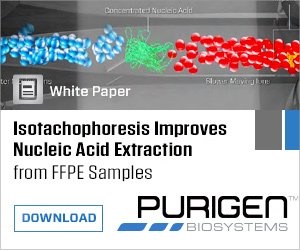An Innovative Approach to Nucleic Acid Extraction from FFPE Samples
Isotachophoresis offers a novel approach to nucleic acid separation that overcomes the limitations and drawbacks of column- and bead-based methods
Translational cancer researchers are constantly striving to identify genetic signatures or profiles that can inform disease etiology and progression as well as guide treatment decisions. A key asset that can assist in the identification of these genetic signatures are the nucleic acids contained within the wealth of formalin-fixed, paraffin-embedded (FFPE) tissue samples available from biobanks and other sample collections. However, while FFPE samples are suitable for long term tissue preservation, they typically contain degraded or fragmented nucleic acids that are hard to access and typically require labor-intensive workflows to recover. As a result, the failure to recover a sufficient amount of nucleic acid to perform downstream molecular analyses such as NGS and PCR (qPCR) is a common occurrence. This increases study costs and can result in studies lacking sufficient power to elucidate certain study objectives.
In recent years, most researchers have replaced liquid-liquid extraction techniques such as phenol-chloroform extraction with technologies that rely on a "catch-and-release" approach based on the principle of solid phase extraction. Two common examples of this approach are column-based and bead-based extractions. The typical workflow used by column- and bead-based purification technologies is tedious and time-intensive. Even with careful optimization, recovery of the necessary yield and quality of nucleic acid from FFPE samples remains a challenge.
Despite the drawbacks of conventional technologies, innovation in sample purification has been limited to slight variations of existing methods. Recently, however, the use of isotachophoresis to separate and isolate nucleic acids has made its way to the commercial market. Isotachophoresis offers a novel approach to nucleic acid separation that overcomes the limitations and drawbacks of column- and bead-based methods. Isotachophoresis separates and concentrates charged molecules in solution, solely based on their electrophoretic mobility or the speed at which the molecule moves within the applied electric field. Unlike conventional electrophoresis, where ions in solution migrate in different directions and at different speeds when an electric field is applied, isotachophoresis purifies an analyte of interest using two buffers, one containing ions with faster electrophoretic mobility and the other containing ions of a slower electrophoretic mobility. This causes the analyte to concentrate between the faster and slower moving buffers as it migrates through the solution. As such, isotachophoresis offers a compelling approach for separating negatively charged nucleic acids from impurities that are positively charged, non-charged, or that are negatively charged with lower electrophoretic mobility.
Emerging products using isotachophoresis offer automated purification of DNA and RNA, including both mRNA and miRNA, from FFPE tissue samples with demonstrated benefits in yield and quality. To implement isotachophoresis, fluidic chips and reagents are used on an instrument that creates an electric field. Since the separation on the instrument occurs in a free solution, there is no binding of the nucleic acid to a surface with subsequent washing and stripping. This minimizes nucleic acid loss and makes the technology very amenable to purification of nucleic acids from FFPE samples or other samples types containing small amounts of nucleic acid. Another benefit offered by isotachophoresis is the elimination of the need to remove paraffin by microdissection or use of harsh deparaffinization chemicals. Early data also suggest that the isolation of nucleic acid is independent or insensitive to fragment length or sequence. This indicates that isotachophoresis can offer the higher quality, higher yield, sample purification solution that oncology researchers have been searching for.


